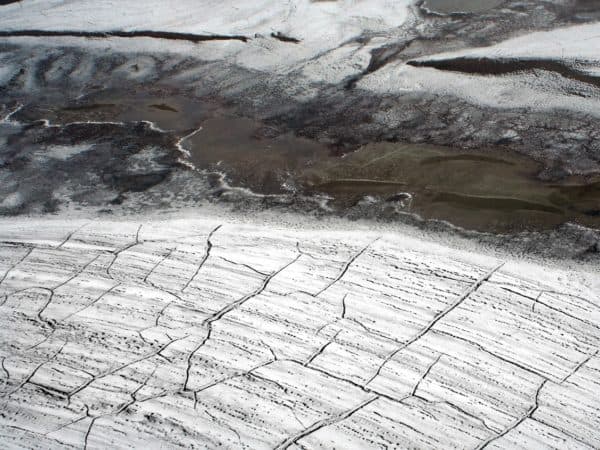
 As permafrost thaws it releases CO2. Just how much is now the subject of a grim debate about our climate.
As permafrost thaws it releases CO2. Just how much is now the subject of a grim debate about our climate.
With respect to global warming, scientists have identified a number of climate feedback loops, vicious environmental cycles which are both caused by and contribute to global warming, effectively accelerating the process of climate change. As the oceans warm and sea ice melts, the Earth loses the reflective power of the ice surface, thereby heating up the oceans more quickly, and as the air warms and heats up surface waters around the planet, more water vapour is created, which itself makes the air hotter.
Also among the top of the known feedback loops is the melting of Arctic permafrost, that layer of soil and rock that has remained frozen for many -often thousands— of years. The melting of permafrost causes the carbon-heavy organic matter which had been previously retained within the frozen permafrost to be exposed to the air where it decays and releases greenhouse gases like carbon dioxide and methane.
Permafrost thaw: CO2 levels could be four times human-created emissions…
How much greenhouse gas is set to be released by the melting permafrost over upcoming decades has been estimated at the equivalent of 100-200 billion tonnes of CO2 by the year 2040, two to four times the amount human-created emissions produce in a year. The new research from the Northwest Territories Geological Survey sheds some more light on the process and has concluded that permafrost decay is affecting some 130,000 square kilometres of landscape in Canada’s North, about the size of New Brunswick, Nova Scotia and PEI put together.
Researchers mapped a 1.27 million km2 area of northwestern Canada using satellite imagery to conclude that climate-driven landscape change is occurring on a wide scale in the North. The research showed that previously contained ground ice is melting in what are called thaw slumps, which can release huge amounts of once-restrained sediment into lakes and rivers, altering the landscape and releasing more CO2 and methane in the process.
“Things have really taken off. Climate warming is now making that happen. It’s exactly what we should expect with climate change,” said Steven V. Kokelj, researcher with the NWT Geological Survey and lead scientist of the new study. “And the maps that we produced clearly indicated it’s not just a random pattern. We’re sort of connecting dots here for the scientific community.”
The bad news is that the Arctic is currently heating up at twice the speed of the rest of the planet, in large part due to the melting ice feedback loop, which means that as more permafrost thaws, CO2 becomes a bigger issue as more ground ice is exposed, sending sediment downstream to collect at headwater stream catchments. The researchers say that the rapid build-up of sediment is typical of deglaciation periods.
“The coupling of thermal and geomorphic processes can expose ground ice directly to surface energy fluxes, rapidly degrading ice-rich terrain and modifying slope and valley configurations,” say the study’s authors. “We conclude that extensive glacigenic deposits imprisoned by permafrost are poised for climate-driven geomorphic transformation.”
The NWT Geological Survey conducts government-funded research on behalf of NWT’s Department of Industry, Tourism and Investment. The new research is published in the journal Geology.
File under: Permafrost thaw CO2
Leave a Reply
You must be logged in to post a comment.




 Share
Share Tweet
Tweet Share
Share




Comment